Learn how King James and The Three Stripes have never officially done business together, but have long done business for each other.
Last weekend, LeBron James saved basketball from the dog days of the summer by appearing at the famed Drew League. Swinging by South Central’s premier pro-am, King James joined NBA peer and Compton native DeMar DeRozan for an unexpected exhibition and played in The Drew for the first time since 2011.
While turnaround jumpers, new shoes, and memorable memes all appeared from LeBron’s impromptu performance, what did not appear was Peter Moore‘s famed Adidas mountain logo on LeBron’s No. 6 Drew League jersey.

The Three Stripe branding along the center of the neckline was cleanly taped over and not visible in any photos that were posted to his audience of over 128 million Instagram followers.
For reference, the Drew League became an Adidas-sponsored institution in May 2022. This shift followed former Nike backing beginning in 2013. While The Drew itself has been a fixture of L.A. hoops for 49 years, it became a mainstream phenomenon in 2011 when numerous NBA players began popping up unannounced due to the league’s lockout.
Since then, The Drew has partnered with the NBPA, Beyond Meat, and now, Adidas.
In light of LeBron’s Drew dominance, we explore the odd relationship between the brand and the baller.
Ohio Player
As an underclassman in Akron, LeBron James wasn’t almost famous, he was already platinum.
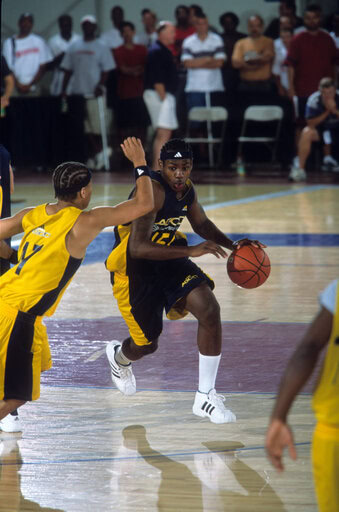
LeBron led St. Vincent-St. Mary High School to back-to-back Ohio State Championships as a freshman and sophomore. By the time he was barely old enough to drive, he’d been named to USA Today’s All-American Team — the first sophomore player to ever do so.
Because of his early success, Ohio’s reigning Mr. Basketball held roundball’s biggest buzz when heading into the summer of 2001. It was at that July’s Adidas ABCD Camp where he made his mark.
Famously, LeBron locked horns with NYC superstar Lenny Cooke in the same seize-the-moment manner that Tracy McGrady did years prior when put up against Lamar Odom.
Much like McGrady, young Bron would have to travel outside of his home state to prove himself wholly to the national powers that be. Adidas ABCD Camp proved the same summer platform for LeBron as that of Five Star for Michael Jordan — or more recently that of Kobe Bryant and McGrady at ABCD.
However, the press machine for James was much stronger than it’d been for a mini Mike Jordan in the ’80s or even a cocky kid named Kobe in the ’90s. National television, wide-reaching print journalism, and an upcoming Internet all made high school stardom much more than a regional thing.
While the world was catching on to King James, Adidas already had a hunch. Before blooming at ABCD Camp, the Three Stripes had already been seeding Bron. Dating back to his sophomore season, Adidas was outfitting LeBron in “Sunshine” styles of The Kobe as well as McGrady’s Mad Handle.
Following 2001’s summer camp come-up, everyone at SVSM was on the wave. In LeBron’s junior year, the whole team was head-to-toe in Adidas: from custom uniforms to the most popular models made by their basketball category.
In 2002, LeBron led all high school hoopers in buzz. Not only was he the first junior to be named Gatorade Player of the Year, but he was also featured on the cover of Sports Illustrated and SLAM Magazine. That same season, SVSM played Carmelo Anthony and the Jordan Brand-backed Oak Hill Academy on ESPN2.
Smartly, Adidas leveraged LeBron by placing him in a pair of Adidas The Kobe Two PEs, gifted by the late Laker legend himself. Not only was Adidas getting TV time from a teenager, they still had another year to double-down on increased coverage.
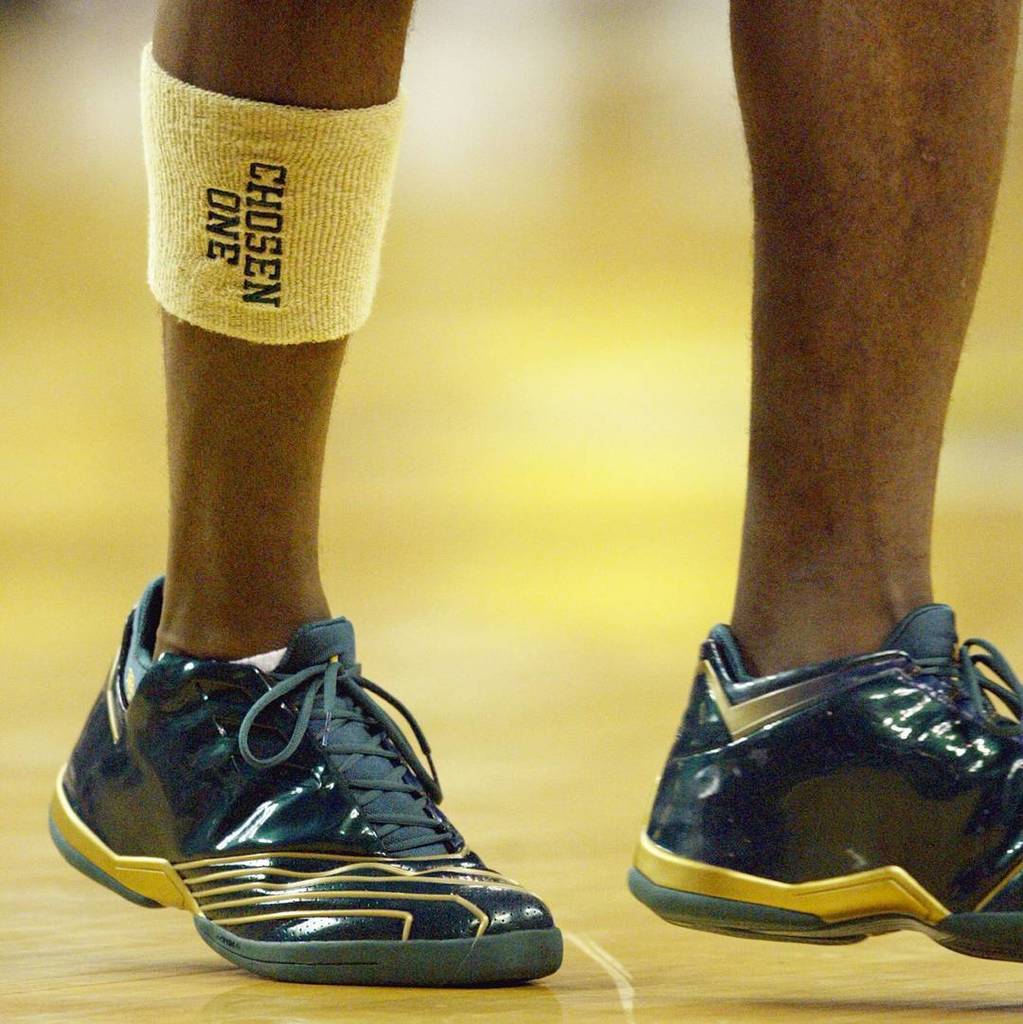
For his final season as an amateur, SVSM starred on ESPN again, going against DJ Strawberry and Nike-sponsored Mater Dei out of California. In that outing, LeBron signaled his future plans by playing in an NBA-branded headband.
However, Adidas won the battle with the rest of the real estate. Despite literally every footwear powerhouse sending player exclusives in green and gold to his doorstep during his high school apex, LeBron broke out 1-of-1 Adidas TMAC 2s. They corresponded with his customized Adidas wristbands.
That spring, the LeBron sweepstakes hit full swing as both Jordan Brand and Reebok treated him like royalty in the high school All-Star Games they sponsored. Still, Adidas appeared to have the inside track.
Though the Three Stripes had been blessing LeBron with threads for three years heading into the 2003 NBA Draft, they’d come up short when it came time to officially making the teenage prodigy the King of Herzog.
Deal or No Deal
Upon graduating from St. Vincent-St. Mary in 2003, LeBron James was one of the most decorated high school athletes of all time.
Adorned in gold medals and golden sneakers, Bron and his boys had taken home trophies at just about every tournament, with the King himself cleaning up on individual accolades. Thanks to two years of unparalleled hype, every brand was budgeting big dollars to pitch LeBron as the face and future of their footwear company.

Famously, LeBron turned down a reported $10 million signing bonus from Reebok on the spot. Not only was the notion of a teenager turning down a check that big breathtaking, it was only the tip of the iceberg. That check was merely a preview of the colossal contract they were offering, said to be worth $110 million over the course of 10 years.
LeBron’s rejection changed the course of his and Reebok’s respective histories.
With the Reebok reserves suddenly freed up, the brand pivoted completely by signing Yao Ming months later, the 2002 No. 1 draft pick who had played his rookie season in Nike. Next, they invested in their lifestyle line of Classics by bringing in 50 Cent.
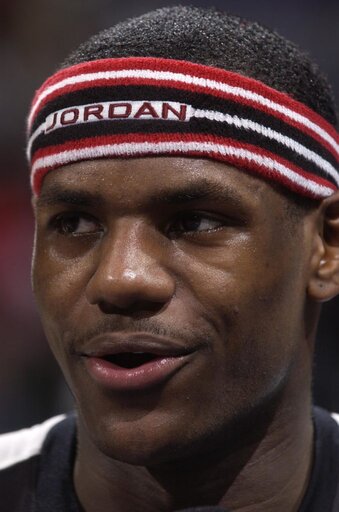
Just days after LeBron wore Reebok in the 2003 McDonald’s All-American Game, the brand announced the signing of Jay Z. Seeing as Hov was one of LeBron’s favorites, perhaps it was partly a positioning play. Maybe it was a reaction to behind-the-scenes talks that suggested the young King was looking elsewhere. Regardless, the dominos dialed up by an 18-year-old phenom changed the trajectory of numerous brands for years on end.
That same season, Jordan Brand, notoriously conservative when breaking the bank for endorsements, kept it close to home by bringing on Carmelo Anthony of Oak Hill and Syracuse fame. By signing Melo for a reported $40 million over six seasons, Jordan suddenly had a new suitor to translate their past and present to a young audience.
So, where would LeBron go?
For years, Adidas lurked and looked like the clear favorite. Despite doing the legwork to build a relationship with LeBron as an amateur, then-Adidas executive, ABCD Camp founder, and sports marketing marvel Sonny Vaccaro kept it real when it came to keeping LeBron laced in Adidas products.
“We will offer you a lot of money,” Sonny said in a relayed report from Sports Illustrated. “But Phil Knight will offer you so much money, you will have to sign with Nike.”
Sonny was right. LeBron and the Three Stripes never made it further than a meeting in Malibu. LeBron linked with Nike for an $87 million megadeal over the course of seven seasons — made even sweeter by a $10 million signing bonus.
That contract completely changed the businesses of all brands when it came to bidding wars. After signing LeBron, Nike spent significantly less money to take on Kobe after his exit from Adidas. As mentioned, Jordan Brand built around Carmelo, while Reebok reset its view on hip-hop and the East.
However, not all was over where Adidas and LeBron were concerned. Eventually, the Three Stripes discovered that the only way to have LeBron back was to have ownership of the items he’d wear every game on his own back.
Jersey Chasing
Despite having $110 million to offer teenage talent in 2003, Reebok was in a different space less than three years later. To no surprise, so was King James.
By 2006, LeBron was already an All-Star and amongst the most popular players in the NBA. In January of that year, Adidas acquired Reebok for $3.8 billion.
The following fall, Adidas assumed control as the official outfitter of the NBA with their Three Stripe logo lacing all warm-up gear and retail items. Timing and money may not have been on the side of Adidas in the summer of 2003, but it was somewhat in their favor for roughly the next decade.
From Fall 2006 through Spring 2017, almost every LeBron James jersey sold was branded by Adidas, as was the majority of Miami Heat and Cleveland Cavaliers clothing.
Over the course of that run, LeBron managed to win three NBA championships, four MVP awards, and appeared as an All-Star starter each season. From replica renditions of Cavs jerseys to title tees and matching Heat caps, all were branded by Adidas.
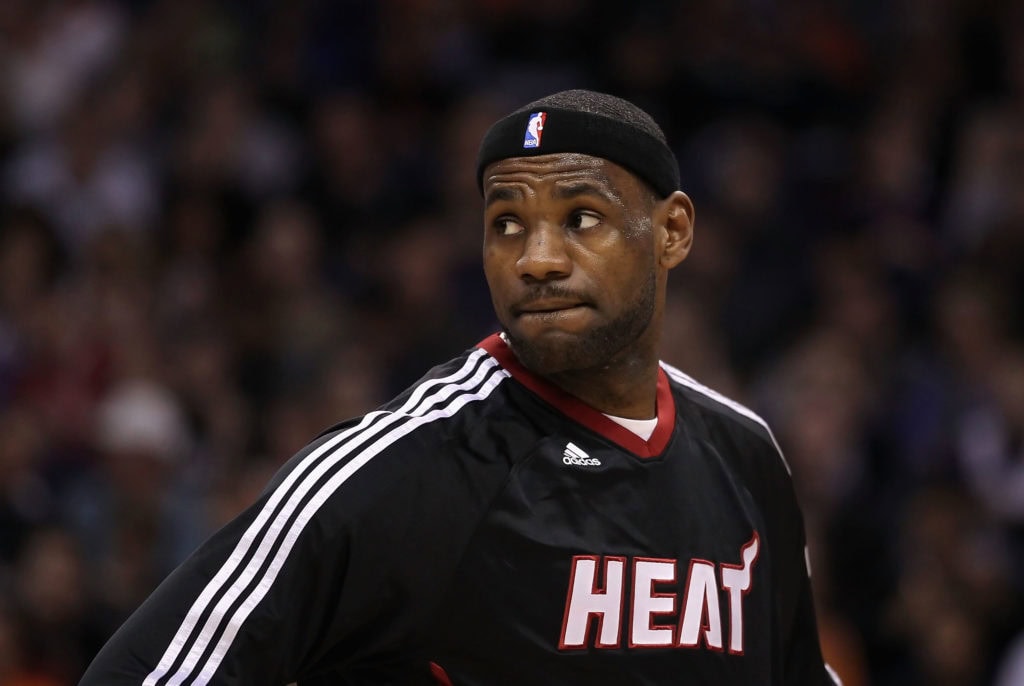
During that same 11-year span, LeBron jerseys finished in the top-four highest sellers for the league each season, often topping the list. Because of this, fans rocked an Adidas logo every time they wore a James jersey. Once again, Adidas was making money off the back of LeBron James — even if they weren’t paying him directly. One could wonder if Adidas won the war even if they lost the battle.
But as the 2010s continued to heat up, the tension between both Bron’s brand and each company’s most magnified endorsers would only grow hotter.
Real Friends
In the 2000s, no footwear free agent was more important than the teenage talent named LeBron James. Over the course of the 2010s, the sheen of sportswear influence would shift monumentally from athlete to artist. In turn, a 30-something creative named Kanye West became the most talked about icon when it came to selling sneakers.
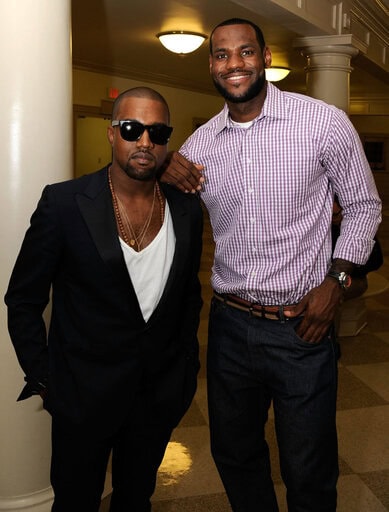
Always around the origin of the next trend and never afraid to orbit controversy, the multi-hyphenate now legally known as Ye alluded to his impact when he was the only public figure to attend LeBron James’ infamous “The Decision” press conference . Seated in sunglasses in the front row, the rapper returning from the public exile of the Taylor Swift VMA incident was rolling out his upcoming album, My Beautiful Dark Twisted Fantasy.
From 2010-13, Kanye name-dropped LeBron in almost every album with the King showing his love by lacing Nike Air Yeezy 2 sneakers. Behind the scenes, the two titans were facing drastically different deals in Beaverton.
In the early ’10s, the Nike LeBron business was booming thanks to a new narrative of going to South Beach and Air Max-assisted signatures that held cache both on and off the court. Conversely, Kanye’s Air Yeezy designs were the toast of sneaker culture, but utterly impossible to get. While the kicks Kanye designed may have benefited in allure thanks to extremely limited availability, West wanted to release many more models and makeups with the help of Nike. For his work and influence, he wanted royalties. And he wanted to be treated with the same status and support as an athlete.
Nike wasn’t about all that.
Infamously, Kanye West left Nike for Adidas. While the two had been buddy-buddy for years on end, LeBron ended up on the receiving end of both compliments and strays, including lines on the Swoosh-slashing “FACTS” released on New Years’ Eve of 2015.
When asked about the lyric, one in which Kanye claimed Nike treated employees “just like slaves” while mentioning LeBron’s brand new deal, the King cleared up any confusion as to which team took his allegiance.
“Obviously, I’m going to side with Nike no matter who it is,” James said in January 2016. “It’s just, it’s family when you talk about Nike, and I’m always on their side no matter what the situation is.”
Once again, this was about more than what was said in public. Only months earlier at NBA All-Star Weekend in February 2015, Ye took the stage at the Roc City Classic in New York City. While performing, West had three massive stripes lit up on his set, urging fans not to wear “that other brand.”
Though James and West continue to show love to each other through homage and quotes, both behemoths of culture compete for a similar space in sportswear. More than that, the battle for footwear and apparel is heightened as both icons currently call Los Angeles home.
How the West Was Won
In 2022, LeBron James is only competing with Father Time.
By becoming a billionaire before the age of 40 and positioning himself to take the top spot on just about every individual NBA record, LeBron will leave the game of professional basketball in an even more decorated fashion than he entered it. Currently, he’s building buzz for the release of his 20th signature sneaker from Nike, a model he made more famous by wearing it at the Adidas-sponsored Drew League.
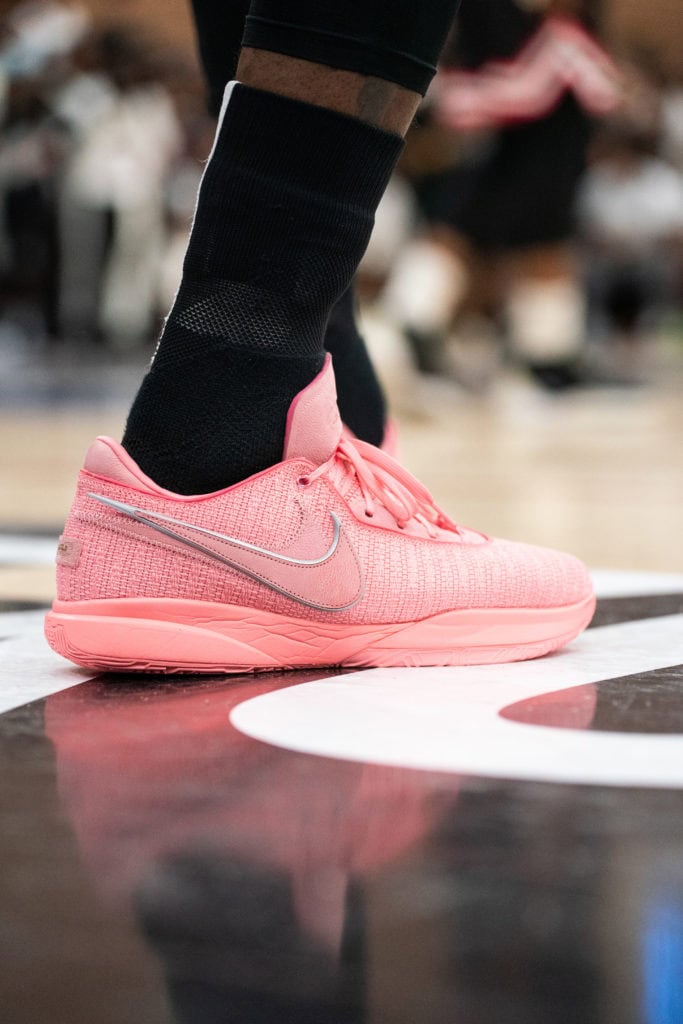
Going big in grassroots after an amateur basketball debacle that led to an FBI investigation, Adidas is once again investing in unsigned talent by sponsoring schools and leagues. In 2022, the brand with the Three Stripes might not benefit from Bron wearing their logo out in public, but they still pulled in traction to their name when he pulled up to Drew League.
These days, the halo effect of LeBron is still one of massive money and influence. By playing in a pro-am game in L.A., numerous streaming services saw more attention than they could handle. Over 950 miles north of The Drew, LeBron has earned more than just equity in Beaverton but even his own building.
Oddly enough, it all goes to show the genius of what Sonny Vaccaro saw in crowded gymnasiums so many times for decades on end. Just like Sonny knew Kobe and Tracy were next, he was well aware from Day 1 that LeBron James was on that same path.
“Kobe allowed LeBron to exist because Kobe is the one LeBron identified with, much more than Michael,” Vaccaro told Peter Verry of Footwear News in January 2020. “We had Kobe help us recruit LeBron. Kobe spoke at ABCD Camp when LeBron was a player there.”
While this reads as storybook, it only sets the stage for the crucial conflict between Adidas and LeBron that Sonny also identified as it was unfolding.
Effectively, Sonny proved just as right about LeBron being the next great as he proved right about Phil Knight having the money to make him an offer he couldn’t refuse. While Nike is known as a marketing machine more than anything, few often offer enough credit for Nike’s ability to adapt and understand what’s going on in the spaces surrounding them.
Using LeBron’s Adidas upbringing as a case study, Nike is perhaps best at letting their competitors pay top dollar to young talent to elicit proof of concept, when coughing up cash for their own endorser investements.
When looking at the brand’s biggest names in 2022, one must remember that Travis Scott signed with Reebok before he released reverse-branded Air Jordans to the masses. Additionally, it was PUMA who paid millions to an up-and-comer named Serena Williams before Nike branded her as their own. LeBron may not have been eligible for a sneaker deal as a high school student, but his unofficial endorsement from Adidas offered insight into what he’d be worth.
The 2022-23 NBA season will correspond with the 20-year anniversary of King James lacing up Adidas for much of his senior season at St. Vincent-St. Mary. Over the course of the last two decades, the two power players have helped each other make millions in multiple ways despite going their own separate ways.
While it may be the tape covering up an Adidas logo at Drew League that’s most talked about in July 2022, it’s the tale of the tape between the two cash cows that’s so much more meaningful.